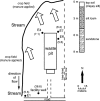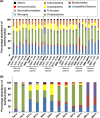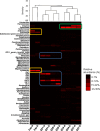Monitoring the perturbation of soil and groundwater microbial communities due to pig production activities
- PMID: 23396341
- PMCID: PMC3623201
- DOI: 10.1128/AEM.03760-12
Monitoring the perturbation of soil and groundwater microbial communities due to pig production activities
Abstract
This study aimed to determine if biotic contaminants originating from pig production farms are disseminated into soil and groundwater microbial communities. A spatial and temporal sampling of soil and groundwater in proximity to pig production farms was conducted, and quantitative PCR (Q-PCR) was utilized to determine the abundances of tetracycline resistance genes (i.e., tetQ and tetZ) and integrase genes (i.e., intI1 and intI2). We observed that the abundances of tetZ, tetQ, intI1, and intI2 in the soils increased at least 6-fold after manure application, and their abundances remained elevated above the background for up to 16 months. Q-PCR further determined total abundances of up to 5.88 × 10(9) copies/ng DNA for tetZ, tetQ, intI1, and intI2 in some of the groundwater wells that were situated next to the manure lagoon and in the facility well used to supply water for one of the farms. We further utilized 16S rRNA-based pyrosequencing to assess the microbial communities, and our comparative analyses suggest that most of the soil samples collected before and after manure application did not change significantly, sharing a high Bray-Curtis similarity of 78.5%. In contrast, an increase in Bacteroidetes and sulfur-oxidizing bacterial populations was observed in the groundwaters collected from lagoon-associated groundwater wells. Genera associated with opportunistic human and animal pathogens, such as Acinetobacter, Arcobacter, Yersinia, and Coxiella, were detected in some of the manure-treated soils and affected groundwater wells. Feces-associated bacteria such as Streptococcus, Erysipelothrix, and Bacteroides were detected in the manure, soil, and groundwater ecosystems, suggesting a perturbation of the soil and groundwater environments by invader species from pig production activities.
Figures





Similar articles
-
Tetracycline residues and tetracycline resistance genes in groundwater impacted by swine production facilities.Anim Biotechnol. 2006;17(2):157-76. doi: 10.1080/10495390600956953. Anim Biotechnol. 2006. PMID: 17127527
-
Tetracycline resistance genes are more prevalent in wet soils than in dry soils.Ecotoxicol Environ Saf. 2018 Jul 30;156:337-343. doi: 10.1016/j.ecoenv.2018.03.041. Epub 2018 Mar 21. Ecotoxicol Environ Saf. 2018. PMID: 29573724
-
Monitoring and source tracking of tetracycline resistance genes in lagoons and groundwater adjacent to swine production facilities over a 3-year period.Appl Environ Microbiol. 2007 Aug;73(15):4813-23. doi: 10.1128/AEM.00665-07. Epub 2007 Jun 1. Appl Environ Microbiol. 2007. PMID: 17545324 Free PMC article.
-
Manure removal system influences the abundance and composition of airborne biotic contaminants in swine confinement buildings.Environ Monit Assess. 2015 Aug;187(8):537. doi: 10.1007/s10661-015-4759-0. Epub 2015 Jul 29. Environ Monit Assess. 2015. PMID: 26220780
-
Comprehensive discovery and migration evaluation of antimicrobial drugs and their transformation products in a swine farm by target, suspect, and nontarget screening.Environ Int. 2023 Nov;181:108304. doi: 10.1016/j.envint.2023.108304. Epub 2023 Nov 3. Environ Int. 2023. PMID: 37931561 Review.
Cited by
-
Assessment of Bacterial Community Assembly Patterns and Processes in Pig Manure Slurry.PLoS One. 2015 Sep 30;10(9):e0139437. doi: 10.1371/journal.pone.0139437. eCollection 2015. PLoS One. 2015. PMID: 26422375 Free PMC article.
-
Combined effects of composting and antibiotic administration on cattle manure-borne antibiotic resistance genes.Microbiome. 2021 Apr 1;9(1):81. doi: 10.1186/s40168-021-01006-z. Microbiome. 2021. PMID: 33795006 Free PMC article.
-
Environmental and Public Health Implications of Water Reuse: Antibiotics, Antibiotic Resistant Bacteria, and Antibiotic Resistance Genes.Antibiotics (Basel). 2013 Jul 31;2(3):367-99. doi: 10.3390/antibiotics2030367. Antibiotics (Basel). 2013. PMID: 27029309 Free PMC article. Review.
-
Manure and Doxycycline Affect the Bacterial Community and Its Resistome in Lettuce Rhizosphere and Bulk Soil.Front Microbiol. 2019 Apr 16;10:725. doi: 10.3389/fmicb.2019.00725. eCollection 2019. Front Microbiol. 2019. PMID: 31057496 Free PMC article.
-
Do animal husbandry operations contaminate groundwater sources with antimicrobial resistance: systematic review.Environ Sci Pollut Res Int. 2024 Mar;31(11):16164-16176. doi: 10.1007/s11356-024-31899-w. Epub 2024 Feb 6. Environ Sci Pollut Res Int. 2024. PMID: 38321277 Free PMC article.
References
-
- USDA November 2012, posting date Quarterly hogs and pigs. USDA, Washington, DC: http://usda01.library.cornell.edu/usda/current/HogsPigs/HogsPigs-09-28-2...
-
- Chee-Sanford JC, Mackie RI, Koike S, Krapac IG, Lin YF, Yannarell AC, Maxwell S, Aminov RI. 2009. Fate and transport of antibiotic residues and antibiotic resistance genes following land application of manure waste. J. Environ. Qual. 38:1086–1108 - PubMed
-
- Arnon S, Dahan O, Elhanany S, Cohen K, Pankratov I, Gross A, Ronen Z, Baram S, Shore LS. 2008. Transport of testosterone and estrogen from dairy-farm waste lagoons to groundwater. Environ. Sci. Technol. 42:5521–5526 - PubMed
-
- Krapac IG, Dey WS, Roy WR, Smyth CA, Storment E, Sargent SL, Steele JD. 2002. Impacts of swine manure pits on groundwater quality. Environ. Pollut. 120:475–492 - PubMed
Publication types
MeSH terms
Substances
LinkOut - more resources
Full Text Sources
Other Literature Sources

